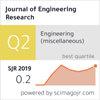基于预定义离散化的简化势源密度函数
IF 2.2
4区 工程技术
Q3 ENGINEERING, MULTIDISCIPLINARY
引用次数: 0
摘要
潜在源贡献函数(PSCF)方法在大气污染源区域分析中得到了广泛的应用,但也存在一些局限性。针对这一局限性,基于高斯过程回归(GPR),提出了潜在源密度函数(PSDF)方法。然而,PSDF模型比PSCF模型需要更多的计算资源。在这里,我们提出了一个提高速度的增强模型。我们通过先验已知的相关长度尺度在细胞之间分配预定的空间相关性,从而离散化PSDF方法。与原PSDF法相比,时间缩短了25-30%,而代表空气污染源的数值与原PSDF法相差不大。我们的新方法减少了计算计算所需的时间,以相当的精度测量潜在源,并保证了结果的可靠性和源强度。本文章由计算机程序翻译,如有差异,请以英文原文为准。
A simplified potential source density function based on predefined discretization
The potential source contribution function (PSCF) method is widely used in the analysis of air pollutant source areas, but it also faces several limitations. To address such limitations, the potential source density function (PSDF) method was developed based on Gaussian process regression (GPR). However, the PSDF model requires more computational resources than the PSCF model. Here, we present an enhanced model with improved speed. We discretized the PSDF method by assigning a predetermined spatial correlation between cells through a priori known correlation length scale. The time taken was reduced by 25–30% from that of the original PSDF method, while the values representing the air pollution sources exhibited only a slight difference from the original ones. Our new method reduces the time required for computational calculations, measures potential sources with comparable precision, and ensures the reliability and source intensity of the results.
求助全文
通过发布文献求助,成功后即可免费获取论文全文。
去求助
来源期刊

Journal of Engineering Research
ENGINEERING, MULTIDISCIPLINARY-
CiteScore
1.60
自引率
10.00%
发文量
181
审稿时长
20 weeks
期刊介绍:
Journal of Engineering Research (JER) is a international, peer reviewed journal which publishes full length original research papers, reviews, case studies related to all areas of Engineering such as: Civil, Mechanical, Industrial, Electrical, Computer, Chemical, Petroleum, Aerospace, Architectural, Biomedical, Coastal, Environmental, Marine & Ocean, Metallurgical & Materials, software, Surveying, Systems and Manufacturing Engineering. In particular, JER focuses on innovative approaches and methods that contribute to solving the environmental and manufacturing problems, which exist primarily in the Arabian Gulf region and the Middle East countries. Kuwait University used to publish the Journal "Kuwait Journal of Science and Engineering" (ISSN: 1024-8684), which included Science and Engineering articles since 1974. In 2011 the decision was taken to split KJSE into two independent Journals - "Journal of Engineering Research "(JER) and "Kuwait Journal of Science" (KJS).
 求助内容:
求助内容: 应助结果提醒方式:
应助结果提醒方式:


